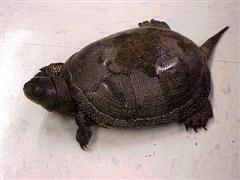European Pond Turtle
European Pond Terrapin Scientific Name: Emys orbicularis
Fri, 4th July, 2025 - 6:50 am GMT
Sponsor Ads:

Alternative Name
European Pond Terrapin Scientific Name: Emys orbicularisBasic Info
The shell of the European Pond Turtle averages between 7 and 14 inches. The top of the shell, or carapace, is oval shaped and smooth. The plastron has a small joint in the middle. Older European Pond Turtles are dark tan, olive green, or brown in color, while the younger animals have yellowish markings on the shell, head, and neck. The pattern of markings on the shell depends on where the turtle is from. Young European Pond Turtles also have yellow rings in their eyes. The European Pond Turtle has limbs similar to those of a tortoise, but their shell more closely resembles the shells of aquatic turtles. They have webbed digits with sharp nails.
Health
Breeding European Pond Turtles usually mate after hibernation in May, although they may breed as early as March and as late as April. The female lays a clutch of between three and sixteen eggs. The clutches are usually larger in the wild. The eggs, which are laid in holes dug in the ground, hatch between August and September. Male European Pond Turtles are smaller and have thicker tails then the females. Males are sexually mature between the ages of 12 and 13, while the female is not mature until she is about 15.Habitat
Found in most of Europe, north Africa, and the Near EastBehavior
The European Pond Turtle is sometimes known as the European Pond Terrapin. They are common throughout Europe and are becoming popular as pets in the United States. European Pond Turtles are a very adaptable species. In the wild, they are found near slow moving or still bodies of water. While there is usually vegetation present, this is not always the case. The lack of vegetation is not a problem as the European Pond Turtle is primarily a carnivore. While female Pond Turtles may eat fruits and vegetables, both males and females generally feed on fish, amphibians, mollusks, insects, crustaceans, small snakes, worms, and small mammals. The European Pond Turtle is a very shy animal towards other species. They usually live in groups of between 5 and 20 Pond Turtles. European Pond Turtles are active between April and October. They hibernate in the winter, usually buried in the mud.Origin
Europe, north Africa, and the Near EastHistory
The similarities the European Pond Turtle has to both tortoises and aquatic turtles earn it the title of "passing-type turtle." They can be found in most of Europe, north Africa, and the Near East.Common Foods
eat fruits and vegetables, both males and females generally feed on fish, amphibians, mollusks, insects, crustaceans, small snakes, worms, and small mammalsSponsor Ads:
An invasion of armies can be resisted; an invasion of ideas cannot be resisted. --Victor Hugo
European Pond Turtle
Coded by: BGID® | ALL RIGHTS RESERVED Copyright © 2000-2025
Disclaimer | Privacy | Report Errors / Contact | Credits








 President of the United States of America - Real Estate mogul, Pageant owner and now one of the most controversial men in political history.
President of the United States of America - Real Estate mogul, Pageant owner and now one of the most controversial men in political history.  Global warming has been in and out as the "latest" hot topic for many years. It is, according to modern scientists, the result of man-made industrial pollutants, clearing forested areas, agriculture, etc. But now they are thinking it started way before the Industrial Revolution...
Global warming has been in and out as the "latest" hot topic for many years. It is, according to modern scientists, the result of man-made industrial pollutants, clearing forested areas, agriculture, etc. But now they are thinking it started way before the Industrial Revolution...  Politician, US Vice President and President of the USA - Joseph Robinette Biden Jr.
Politician, US Vice President and President of the USA - Joseph Robinette Biden Jr.  versus
versus  Russia: 'The Evil Empire'? Are they all that bad or is it just the USA trying to portray Russia as bad because they are a world power with land bigger and a society very different from the USA ideal?
Russia: 'The Evil Empire'? Are they all that bad or is it just the USA trying to portray Russia as bad because they are a world power with land bigger and a society very different from the USA ideal? 
 Corona virus
Corona virus 
 Users with wide screen monitors can benefit from more content on every page.
Users with wide screen monitors can benefit from more content on every page.